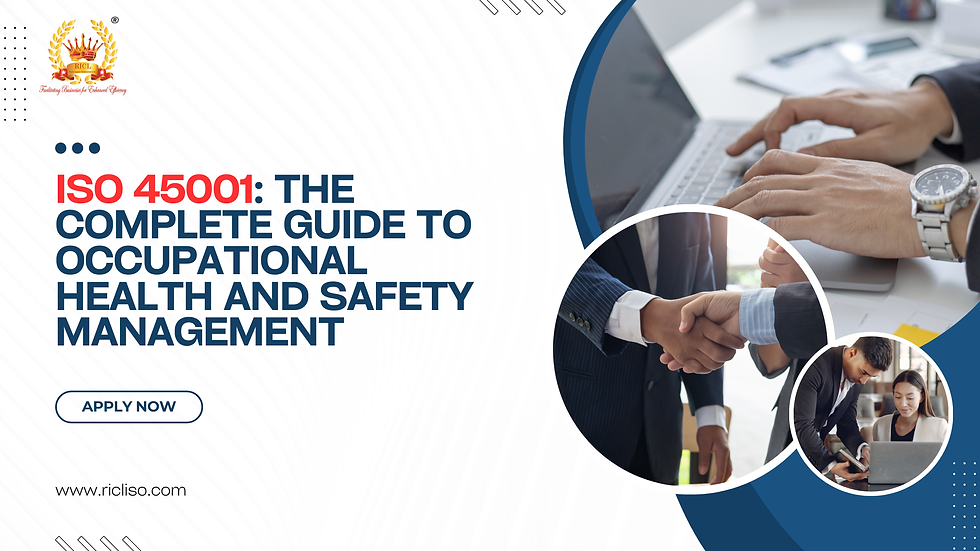Why ISO Certification Promotes Quality?
- teamitricl
- Aug 7
- 3 min read

ISO certification promotes quality through its rigorous standards and systematic approach to quality management. Here are several ways in which ISO certification contributes to promoting and ensuring quality within organizations:
1. Standardization of Processes
ISO standards, such as ISO 9001 for Quality Management Systems (QMS), require organizations to establish documented processes and procedures for all aspects of their operations. This standardization ensures consistency in how tasks are performed, from production and service delivery to customer interactions and internal audits. By adhering to standardized processes, organizations minimize variation, reduce errors, and improve the reliability of their outputs, thereby promoting quality across all levels of the business.
2. Focus on Customer Satisfaction
ISO standards place a strong emphasis on meeting customer requirements and enhancing satisfaction. ISO 9001, for example, requires organizations to determine and monitor customer expectations, measure customer satisfaction, and implement processes to address customer feedback. This customer-centric approach ensures that products or services consistently meet or exceed customer expectations, leading to higher satisfaction levels and improved quality perception.
3. Continuous Improvement
One of the fundamental principles of ISO standards is continuous improvement. ISO-certified organizations are required to regularly assess their processes, products, and services, identify areas for improvement, and implement corrective actions. This cycle of continuous improvement ensures that organizations remain proactive in addressing quality issues, optimizing performance, and enhancing customer satisfaction. By fostering a culture of continuous improvement, ISO certification promotes ongoing learning, innovation, and adaptation to changing market conditions, ultimately driving higher quality standards.
4. Risk-Based Thinking
ISO standards advocate for risk-based thinking as part of quality management. Organizations are encouraged to identify and assess risks that could affect their ability to deliver products or services that meet customer requirements. By understanding and mitigating these risks, organizations can proactively prevent quality issues, reduce waste, and improve overall operational efficiency. This systematic approach to risk management ensures that quality considerations are integrated into strategic planning and decision-making processes, enhancing the organization’s ability to consistently deliver high-quality outcomes.
5. Employee Involvement and Competence
ISO certification promotes employee involvement in quality management processes and emphasizes the importance of competent workforce. Employees are encouraged to contribute to the development, implementation, and improvement of quality management systems. Training and development programs ensure that employees have the necessary skills and knowledge to perform their roles effectively and contribute to maintaining and enhancing quality standards. Engaged and competent employees play a crucial role in driving quality improvement initiatives, fostering a culture of accountability, and promoting a shared commitment to quality across the organization.
6. Enhanced Supplier Relationships
ISO certification also extends its quality focus to supplier relationships. ISO standards require organizations to establish criteria for selecting suppliers, evaluate their performance, and collaborate closely to ensure that purchased products and services meet quality requirements. By maintaining high standards in supplier relationships, organizations can minimize the risk of quality defects and disruptions in the supply chain, ensuring consistent quality throughout the production or service delivery process.
Conclusion
ISO certification promotes quality by establishing standardized processes, focusing on customer satisfaction, encouraging continuous improvement, adopting risk-based thinking, promoting employee involvement and competence, and enhancing supplier relationships. These elements collectively contribute to creating a culture of quality within organizations, where consistency, reliability, and customer-centricity are prioritized. By implementing and maintaining ISO standards, organizations can systematically improve their quality management practices, enhance operational efficiency, and ultimately deliver products or services that meet or exceed customer expectations, thereby gaining a competitive advantage in the marketplace.






Comments